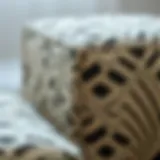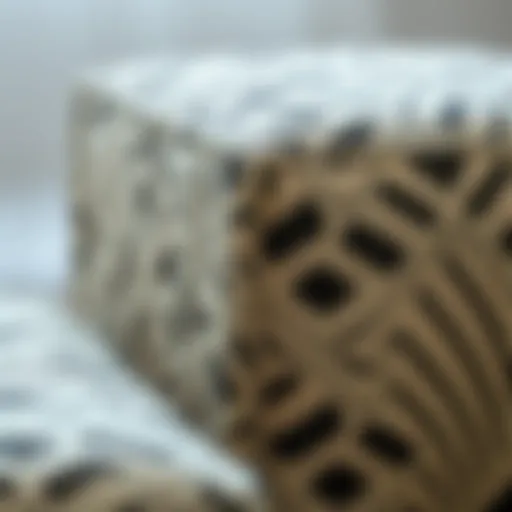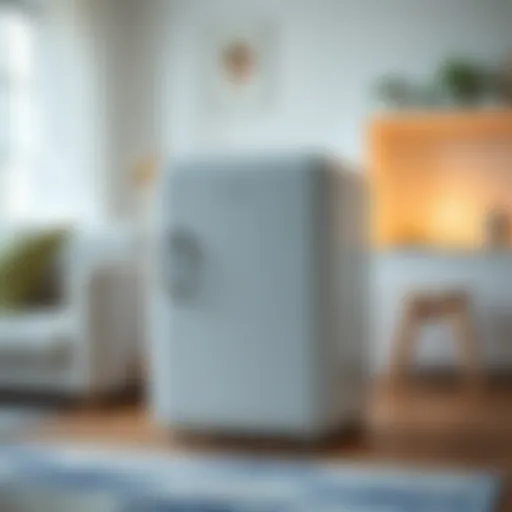Maximizing Small Apartment Outdoor Spaces with Smart Furniture


Intro
In today’s urban landscape, small apartments continue to rise, often leaving little room for sprawling outdoor spaces. However, these compact balconies, patios, and terraces present a canvas ripe for creativity. With a thoughtful selection of outdoor furniture, residents can craft their personal oasis, transforming these small areas into multifunctional extensions of their homes. This article embarks on a journey through the nuanced decision-making process involved in optimizing your small outdoor spaces. Whether it’s choosing materials that withstand the elements or finding designs that amplify comfort and style, every detail matters. Let’s unravel how these careful choices can bring life and functionality to your outdoor retreat, ensuring it becomes a cherished spot.
Design Trends
Transforming outdoor spaces begins with an eye for design trends that resonate with personal aesthetics and practical needs. Small doesn’t mean uninviting; instead, it challenges us to think innovatively.
Current Trends in Furniture Styles
A few noticeable trends are emerging in the realm of outdoor furniture designed for compact spaces:
- Modular Designs: Pieces that can be reconfigured to suit various needs are becoming increasingly popular. These are particularly useful in small spaces where flexibility is essential.
- Sustainable Materials: As we collectively become more conscientious about our environmental footprint, furniture made from recycled or sustainably-sourced materials gains traction. Think bamboo lounge chairs or recycled plastic tables—functionality meets eco-friendliness.
- Minimalist Aesthetics: Stripping away the unnecessary visually declutters a small area. Simple lines and muted colors can create an inviting yet sophisticated environment, avoiding the feeling of being cramped.
How to Incorporate Trends into Your Space
Incorporating these design trends can be simplified by following a few straightforward strategies:
- Choose Space-Saving Options: Look for furniture that folds away or stacks neatly. A folding bistro table can accommodate dining one night and become a canvas for potted plants the next.
- Mix and Match Textures: Combining different materials can add depth to your space. For example, a rattan chair paired with a sleek metal table can strike an appealing balance.
- Use Vertical Space: Don’t shy away from utilizing wall planters or shelves, which can free up ground space while injecting life through greenery.
- Personal Touches: Include personal elements such as outdoor cushions or throws that reflect your style. Little touches can make a small space feel much more inviting.
"A good outdoor space isn’t just about its size; it’s about its functionality and how well it serves your lifestyle."
Buying Guides
Navigating the world of outdoor furniture buying can feel daunting. The following guidelines aim to demystify the process and highlight key considerations for homeowners.
Choosing the Right Furniture for Different Rooms
The type of furniture you select should reflect not just your style but also the functions each area will serve:
- Dining Areas: Prioritize weather-resistant materials. You could consider a compact dining set that allows for easy entertaining without dominating the space.
- Lounge Zones: Opt for comfortable seating that encourages relaxation. Consider lightweight options made from all-weather fabric that can be easily moved around as needed.
- Garden Spaces: If you have a small garden section, look for pots and planters that won’t take up too much room but can still showcase your plants.
Tips for Assessing Quality and Value
When investing in outdoor furniture, quality should weigh heavily in your decision. Pay attention to:
- Material Durability: Examine the materials used in the construction. For instance, cast aluminum can withstand rust while keeping the furniture lightweight.
- Warranties: A solid warranty can offer peace of mind, indicating that the manufacturer believes in the durability of their product.
- Customer Reviews: Before committing, check what others say about the product’s performance in real-life situations. Websites such as reddit.com often have honest user testimonials.
In summation, optimizing a small apartment outdoor space isn’t just about cramming in furniture. It’s about meticulous selection and arrangements that harmonize with your lifestyle and aesthetic preferences. With the right strategies and a keen eye on current trends, even the tiniest of areas can blossom into a personal paradise that invites both relaxation and admiration.
For more insights on furniture design, materials, and tips on creating compact outdoor spaces, refer to sources like britannica.com or en.wikipedia.org. Look at local retailers for options that suit your needs and budget.
Understanding Outdoor Spaces in Small Apartments
In today's urban living environment, small apartments are increasingly popular, providing cozy dwellings amidst bustling city life. However, these compact spaces often leave much to be desired, especially regarding outdoor areas. When we talk about optimizing outdoor spaces in these small settings, it's more than just filling a balcony or patio with furniture; it’s about creating an inviting atmosphere that enhances the quality of life.
Understanding the nuances of small outdoor spaces involves several factors, from everyday usage to design aesthetics. Space management isn't just a buzzword—it’s a philosophy. A well-thought-out approach can transform what might feel like an afterthought into a cherished retreat. The trick lies in choosing the right pieces of furniture that make the most of the limited square footage.
Defining the Concept of Small Outdoor Areas
Small outdoor areas can be anything from a tiny balcony to a shared courtyard, or even a compact garden. The definition leaps beyond mere dimensions; it encapsulates a realm of possibilities that often gets overlooked. Think about it—these spaces, however limited, offer a fresh breath of air, a place to witness sunsets, or a venue for intimate gatherings.
To define these areas accurately:
- Size matters, indeed, but the layout and accessibility are equally important. A narrow strip might be small but could comfortably fit a cozy bistro set.
- Functionality is key. Do you envision a quiet reading spot, a dining area for two, or a lush garden? The intent guides the design and layout.
- Integration with the interior poses an aesthetic challenge. Letting the outdoor vibe harmoniously flow with indoor decor can transform the entire feel of both spaces, making them more interconnected.
These definitions set the stage for appreciating the truly diverse role that outdoor spaces can play in small apartments.
The Benefits of Outdoor Living
Outdoor living is not merely a trend; it’s a lifestyle choice that comes wrapped with numerous benefits. The tangible advantages can significantly boost a resident's daily experience.
- Mental Health Boost: Having a personal space outdoors can provide a much-needed respite where one can unwind from the rigors of daily life. Fresh air works wonders for the soul, after all.
- Social Connections: Outdoor areas become extensions of living rooms, offering a stage for small gatherings. Whether it’s a weekend get-together or a simple dinner under the stars, these moments foster connections.
- Aesthetic Appeal: A well-designed outdoor space adds curb appeal and potentially increases the property value. It’s that cherry on top that makes a place truly inviting.
- Green Thumbs Unite: Small outdoor spaces afford the chance for gardening, be it herbs on a balcony or flowers in pots. Gardening fosters a connection with nature, which often eludes us within the confines of urban life.
"Outdoor spaces elevate the functionality of any home, creating environments that inspire and rejuvenate."
In essence, considering the importance of outdoor spaces within small apartment living is paramount. It’s about making the best of what you have and crafting an oasis that resonates with the individual's lifestyle and preferences.
Key Considerations for Selecting Outdoor Furniture
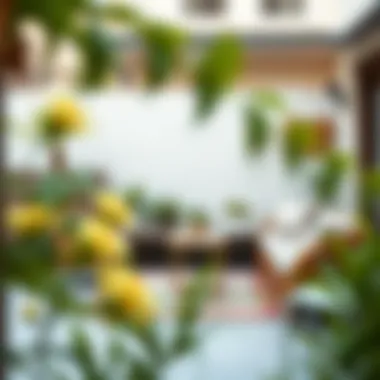

Choosing the right outdoor furniture is an essential part of transforming small apartment spaces into functional havens. The process of selecting furniture goes beyond mere aesthetics; it involves balancing space availability, personal requirements, and environmental factors. By focusing on the specific elements of design, practicality, and comfort, homeowners can create an inviting outdoor area that complements their lifestyle and preferences. This section dives into the key considerations for choosing outdoor furniture that enhances small outdoor spaces while ensuring they remain practical.
Assessing Available Space
Measuring Dimensions
When it comes to outdoor furniture, the ability to measure dimensions accurately can't be overstated. This process isn't just about knowing the length and width; it entails understanding the area’s spatial dynamics. Knowing how much room there is helps you visualize where each piece of furniture fits. Proper sizing ensures that you don’t end up with items that dwarf the area or leave insufficient space to move around. For instance, a bistro set might be perfect for a narrow balcony, while an oversized table could make the same space feel cramped.
The key characteristic of measuring dimensions lies in its precision. It’s not merely a beneficial choice; it’s a critical one. Locking down exact measurements helps avoid the potential pitfall of purchasing furniture that is either too large or too small. One unique aspect of this part of the process is that it enables you to factor in essential walking paths and space for other features, like potted plants. Neglecting to properly measure can lead to inadvertent mistakes, leaving you with a mismatched and awkward arrangement.
Identifying Fixed Elements
Another significant aspect of optimizing small outdoor spaces is identifying fixed elements such as railings, fences, or structural supports. These elements undoubtedly affect your choices and placements. Fixed elements can limit the area where you can place furniture but also provide unique opportunities for creative arrangement.
The main characteristic of recognizing these fixed aspects is that it accounts for the layout of your space. It's a popular consideration as it shapes how one approaches furnishing their outdoor nook. Take note of any fixtures that will dictate the design flow, as they can either complement or hinder the overall aesthetic. Not considering these elements can lead to difficulty in accessing furniture and ultimately an uninviting space. Remember, the goal is to harmonize the fixed components with the movable pieces.
Understanding Needs and Usage
Intent of Use
Determining the intent of use is pivotal in selecting the right outdoor furniture. Are you looking to create a serene spot for morning coffee, or is it more about hosting gatherings? Understanding your primary goal allows you to choose pieces that align perfectly with your lifestyle. This makes the intent of use both a beneficial and strategic consideration.
The unique aspect of defining how you intend to use the space lays the framework for all other decisions. If you plan to host barbecues and family get-togethers, then larger tables and ample seating will be your priority. On the flip side, if it’s for solo relaxation, a cozy chair along with a small side table might suffice. Failing to align your furniture needs with your space's purpose risks creating a setup that feels underutilized or excessive.
Number of Users
Equally crucial in the equation is the number of users. Knowing how many people will typically be using your space at once directly influences the scale and style of your furniture. This aspect is fundamental because selecting the right pieces ensures that everyone has a comfortable spot, making the experience enjoyable.
The key feature here is practicality. Furniture designed for few users can leave a space feeling empty and impractical for larger gatherings. Conversely, cramming in too many large pieces can obstruct flow and make the area feel cluttered. Finding that sweet spot in balancing size and usability leads to a cohesive and functional outdoor area where everyone can enjoy themselves.
Weather and Environment Considerations
Material Durability
Material durability speaks volumes when it comes to longevity and ease of maintenance. Investing in stuff that can withstand the test of time—whether due to sun exposure or heavy rain—will save you headaches down the line. This factor is invaluable for selecting outdoor furniture, especially for small spaces where each item is even more closely scrutinized for its effectiveness.
The key characteristic of durable materials is that they ensure resilience against the changing seasons. For example, teak is often touted for its natural resistance to decay, making it ideal for outdoor environments. This durability is a strong point, as it means furniture won't need to be replaced frequently, so your investment lasts longer. The downside? Sometimes, durable materials come with a heftier price tag.
Seasonal Variations
Finally, consider how seasonal variations play a role in outdoor furniture choices. Your area may swing from harsh winters to sweltering summers, and this, in turn, should determine what you buy. Materials, designs, and maintenance plans must adapt to seasonal changes; for example, while aluminum can withstand both rain and sun effectively, it might not offer the insulation some users seek in colder climates.
The unique feature here is the capacity to swap out accessories seasonally, like cushions or covers, to extend the usability of your furniture. This requires a conscious plan and some foresight but leads to a more enjoyable space throughout the year. Not considering this variability could lead to wear and tear that detracts from both appearance and functionality.
Ultimately, balancing all these key aspects in choosing outdoor furniture will yield a space that is not only stylish but practically serves your lifestyle needs.
Types of Outdoor Furniture for Small Spaces
In the pursuit of optimizing small apartment outdoor spaces, understanding the diverse types of outdoor furniture is crucial. Outdoor furniture serves not only as a functional element but can also enhance the aesthetic appeal of your limited space. The right choices can turn a cramped balcony or tiny patio into a cozy retreat or charming hangout spot. Hence, delving into space-saving solutions, multifunctional pieces, and minimalist designs is essential to ensure each item pulls its weight in providing comfort, style, and utility.
Space-Saving Solutions
Folding Tables and Chairs
Folding tables and chairs are the very essence of adaptability. These pieces can be collapsed and tucked away when not in use, allowing you to reclaim precious square footage. The primary characteristic of folding furniture is its convenience; you can whip them out for a dinner al fresco or fold them away after a casual gathering with friends.
One major advantage is their portability; you can easily transport them to wherever the action is. Yet, it’s crucial to consider quality when selecting folding furniture, as cheaper options might compromise comfort. Some may find them a little less sturdy compared to traditional pieces, but with the right materials, like high-grade aluminum or treated wood, they can prove to be both durable and stylish.
Stackable Furniture
Stackable furniture takes the brilliance of space-saving to another level. This variety of furniture allows you to literally stack individual pieces on top of each other when they’re not in use. It’s like a game of Tetris; when you’re done entertaining, you can clear your outdoor space in a pinch.
The standout feature of stackable furniture is its versatility. Available in various styles and materials, they can adapt to the aesthetic of your outdoor area, ensuring you don’t sacrifice style for space. However, it’s essential to be mindful of comfort; some stackable chairs might not provide the best seating experience if designed mainly for storage. It’s about striking the right balance between practicality and relaxation in your setup.
Multifunctional Pieces
Sofa Beds
Sofa beds are a godsend for small outdoor spaces. They offer two-in-one functionality—both seating and sleeping arrangements—without requiring excessive space. The versatility allows for spontaneous overnight stays without needing a dedicated guest room.
Besides being practical, they can be stylish. Many contemporary sofa beds come in chic designs that can flatter your outdoor aesthetic. A common drawback, however, is that some models can be quite heavy, making them less ideal for quick rearrangements. Also, quality varies widely; investing in a good one can make all the difference in terms of comfort and durability.
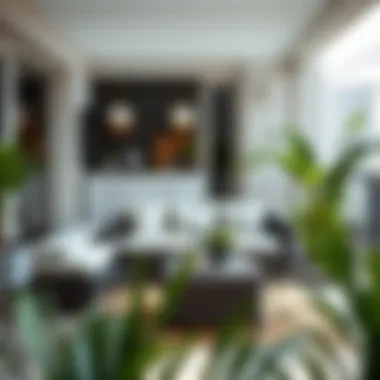

Storage Ottomans
Storage ottomans double as seats and disguised storage solutions. Positioned around a small outdoor table, they can accommodate additional guests while providing a nifty place to stow away patio essentials, such as cushions or blankets. This duality is essential for optimizing a small outdoor area.
Their unique feature lies in their ability to combine form and function seamlessly. While some might associate ottomans with more casual designs, there are plenty of elegant options made from durable materials that maintain a polished look. The challenge can be finding one that perfectly suits your space without coming off as bulky or clunky; it’s wise to choose weight and style wisely.
Compact and Minimalist Designs
The emphasis on compact and minimalist designs is vital for small areas where less truly is more. Clean lines, subdued colors, and an absence of excessive ornamentation create an uncluttered feel, making outdoor spaces appear larger than they actually are. Furthermore, minimalism often cultivates a calm environment, enabling relaxation and enjoyment of the outdoors.
When selecting furniture for a small outdoor area, always aim for pieces that complement each other and create a coherent look. Through thoughtful furniture choices that blend function with simplicity, your small outdoor stay can transform into a delightful escape, regardless of its size.
Material Choices for Outdoor Furniture
When it comes to smaller outdoor areas, the materials used for furniture can make or break the space's functionality and aesthetics. Thoughtful choices reflect not just personal style but also how well the furniture stands up to outdoor elements. By considering durability, maintenance needs, and design appeal, one can create a seamless and inviting extension of their living area.
Exploring Durability Options
Durability is paramount in outdoor furniture selection. After all, nobody wants to invest in a piece that’ll start to wear out after a season or two. Additionally, in small spaces, the last thing you want is furniture that doesn’t hold up.
Teak and Eucalyptus
Teak and eucalyptus are both shining examples of durable wood options for outdoor furniture. The strength of teak lies in its natural oils that resist moisture, insects, and decay. This characteristic is what gives teak its longevity and why it is highly sought after. The warm, golden hues add a touch of luxury, making it a popular choice among homeowners looking to elevate their outdoor decor.
Eucalyptus, a less expensive alternative, also offers great durability. Its dense, natural wood has similar moisture-resistant qualities to teak, making it suitable for various climates. However, while eucalyptus might not last as long as teak when exposed to harsh weather conditions, it provides a stylish and budget-friendly option for those on a tighter budget.
Both materials do require some maintenance; regular oiling can enhance their appearance and extend their lifespan.
Aluminum and Steel
When it comes to metal options, aluminum and steel showcase their own unique set of advantages. Aluminum is lightweight, rust-resistant, and easy to maneuver. This makes it perfect for small spaces where flexibility is essential. Over time, aluminum can be molded into sleek, modern designs that catch the eye.
On the flip side, while steel offers immense durability and sturdiness, it requires more maintenance. Steel can rust if not properly treated. However, with the right powder-coated finish, it can withstand tough weather, making it a viable choice. Both metals stand up well against the elements, but it’s essential to think about which one fits your lifestyle better.
Weather Resistance and Maintenance
Choosing materials goes hand in hand with considering weather resistance. The outdoor environment can be unforgiving, so understanding how materials react with sun, rain, and wind is crucial.
UV Protection
UV protection is significant in prolonging the life of outdoor furniture. Ultra-violet rays can wreak havoc, fading colors and degrading materials over time. A key characteristic of UV-resistant finishes is their ability to block harmful radiation, maintaining the integrity of your furniture.
Investing in UV-protected pieces means you’ll spend less time worrying about refurbishing or replacing furniture. However, be aware that some finishes may wear off over time, so regular maintenance checks are advisable.
Waterproof Finishes
Waterproof finishes are another vital consideration. Just as a raincoat protects you from the downpours, waterproofing helps furniture resist water damage. Such finishes form a protective barrier that keeps water from seeping into materials, greatly reducing the risk of mold and mildew.
While many manufacturers provide waterproof solutions, it’s essential to verify that these finishes are actually suitable for your intended material. On the downside, some waterproof treatments may alter the natural appearance of the material. However, the investment in such finishes often pays off in longevity and performance.
Sustainable Materials and Practices
As more people become environmentally conscious, the choice of sustainable materials gains significance. Selecting sustainable furniture goes beyond aesthetics; it aligns with ethical practices and environmental responsibility.
Looking for furniture crafted from reclaimed wood or recycled materials not only helps reduce waste but is often one-of-a-kind. Plus, many sustainable materials come with certifications ensuring they meet environmental standards. Performance and aesthetic appeal remain intact while contributing to a greener planet. Promoting sustainability is as much about personal values as it is about style—your choice can tell a compelling story in any outdoor setting.
By being mindful of material choices, not only can you optimize the limited space of a small apartment, but you can also create an enduring and stylish outdoor oasis that speaks volumes about personal taste and lifestyle.
Design Aesthetics for Cohesion
Creating an inviting outdoor space in a small apartment hinges on aesthetics that unify and complement both the furniture and the surrounding environment. Design aesthetics, in this context, are about more than just appearance; they play a vital role in transforming limited areas into functional and enjoyable extensions of indoor living. Thoughtful decisions about color, texture, and the integration of plants contribute significantly to the overall ambiance, making outdoor spaces usable and appealing.
Color Schemes and Textures
Understanding which color schemes and textures enhance your outdoor space is essential. Colors can evoke feelings and set the tone for relaxation or social gatherings. For instance, vibrant hues like yellows and oranges can create a lively atmosphere, while cool tones such as blues and greens can impart calmness. Pairing different textures—like a rough wooden table with soft fabric cushions—adds depth and interest. The interplay of these elements can lead to an aesthetic that feels both cohesive and tailored.
Additionally, choosing colors that resonate with the natural surroundings can help the furniture blend seamlessly with the environment. Opting for earthy tones or shades inspired by local flora can bridge the gap between indoor and outdoor spaces, making everything feel more cohesive.
Incorporating Plants and Greenery

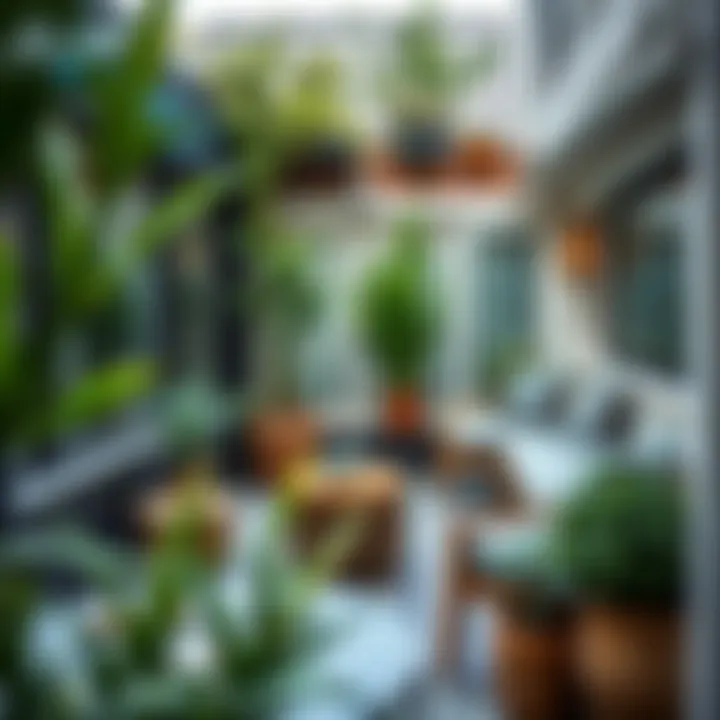
Planters and Vertical Gardens
Planters and vertical gardens have become significant in apartment outdoor spaces for their ability to maximize limited room while adding a touch of nature. A key characteristic of vertical gardens is that they utilize wall space effectively, allowing homeowners to introduce greenery without taking up valuable floor space. This kind of setup can contribute immensely to aesthetic appeal, enhancing the atmosphere with natural elements.
Moreover, vertical gardens are often seen as a popular choice due to their versatility; they can be fashioned from various materials like wood, metal, or fabric, and can hold a range of plants from flowers to herbs. The advantage lies in their ability to draw the eye upwards, creating an illusion of height and potentially making the area feel larger than it is.
However, one should consider the maintenance associated with these gardens. Regular watering and plant care are essential to keep them thriving and visually appealing.
Choosing Low-Maintenance Plants
Choosing low-maintenance plants is a strategy well-suited for small outdoor spaces, given the often-busy lifestyle of apartment dwellers. Key characteristics of these plants include hardiness and minimal upkeep, offering a range of choices that can thrive in various conditions. Succulents and certain types of grasses, for example, require little water and can adapt to different lighting situations, making them appealing to those who might not have a green thumb.
These plants enable apartment owners to decorate their spaces with greenery while ensuring they do not become a burden. The unique feature of low-maintenance plants is that they can fill outdoor areas with life, boost air quality, and create a pleasing aesthetic without the hassle of complex care routines. The disadvantage to keep in mind, however, is the limited variety compared to traditional gardens; this means careful selection is crucial to ensure visual diversity and interest.
Creating Comfortable Atmospheres
Cushions and Fabrics
In any outdoor space, cushions and fabrics are often the unsung heroes of comfort and aesthetics. These elements can transform cold, hard furniture into inviting spots for relaxation and enjoyment. A key characteristic of cushions is their ability to introduce color, warmth, and texture, effectively softening a space that might otherwise feel stark.
Choosing the right fabrics is vital; materials like outdoor-resistant canvases or breathable, water-repellent textiles ensure that cushions remain functional despite exposure to various weather conditions. While these options increase comfort drastically, one must also manage the trade-off between aesthetic appeal and durability—especially in small settings where space is at a premium.
Lighting Elements
Lighting elements play a crucial role in enhancing the usability and charm of small outdoor areas, especially during the evening hours. Whether you choose small string lights, decorative lanterns, or solar-powered garden lights, the key characteristic of these items is they create an inviting glow that can turn an ordinary garden into a magical escape.
Remote solar options are particularly favorable for small spaces, as they require no wiring and come in various styles to fit the personal aesthetic of the space. The unique advantage of well-placed lighting is its capacity to create a warm, enchanting atmosphere while also enhancing safety after dark, ensuring that your outdoor area is functional around the clock.
Overall, combining thoughtful color choices, appealing plant life, comfortable furnishings, and effective lighting can create a beautifully cohesive outdoor space, making even the smallest apartment feel homey and inviting.
Maintenance Tips for Outdoor Furniture
Caring for outdoor furniture is akin to bonding with a good friend; it requires attention, understanding, and a bit of effort. When it comes to small apartment outdoor setups, the right maintenance can extend the longevity of your furniture, ensuring that each piece stays as fresh as a daisy through changing seasons. Not only does proper care help preserve aesthetics and functionality, but it also protects your investment in outdoor decor. By following a few straightforward maintenance practices, you can enjoy all the benefits of your outdoor space without worries about wear and tear.
Basic Cleaning Protocols
To keep your outdoor furniture looking tip-top, establishing a basic cleaning routine is essential. Here are some simple yet effective steps you can follow:
- Dust Regularly: Use a soft cloth or a duster to remove dirt and debris from surfaces. A little dusting can go a long way in maintaining your furniture's appeal.
- Gentle Washing: Once a month, use warm, soapy water to wipe down surfaces. Avoid harsh chemicals that could damage the finish. You can use a mild detergent mixed with water and a sponge for this task.
- Rinse Thoroughly: Make sure to rinse off any soap residue with clean water. Leftover soap can attract dirt, which defeats the purpose of cleaning.
- Dry Completely: After washing, allow your furniture to dry fully before covering it or putting it back in use. This helps prevent mildew and rust formation, especially in metal pieces.
Seasonal Care Practices
Seasonal changes can be harsh on outdoor furniture, particularly in areas with extreme weather conditions. Adjusting your care practices can make a world of difference:
- Spring Spruce-Up: As the weather warms up, give your furniture a thorough cleaning to remove winter grime. Check for any damages, like peeling paint or rust, and address those promptly.
- Summer Shielding: In the heat of summer, sun exposure can fade colors and weaken materials. Utilize protective covers when furniture isn’t in use. Consider placing your furniture in shaded areas to minimize sun damage.
- Fall Prep: Before the first frost, make sure to clean and treat your furniture. Applying a weatherproof sealant, especially on wood, can act like a coat to shield from moisture.
- Winter Wrap-Up: Depending on your location, it may be wise to store your outdoor furniture indoors during particularly harsh winters. If that’s not possible, use high-quality covers to protect against snow and ice.
Long-Term Preservation Strategies
For those who see outdoor living as an extension of their home, taking long-term preservation steps can make your outdoor spaces last through the ages:
- Quality Over Quantity: Invest in high-quality materials when purchasing furniture. While it may be tempting to buy the cheapest options, they often won’t hold up through time like durable choices such as teak or aluminum.
- Regular Inspections: Make it a habit to check your outdoor furniture regularly for signs of damage or wear and tear. Catching issues early can save both time and money.
- Protective Treatments: Many materials benefit from protective treatments that ward off stains or fading. Consider using oils for wooden furniture, sprays for fabric cushions, and rust-proof coatings for metal chairs.
- Proper Storage Solutions: When possible, use space-efficient storage solutions that safely house furniture during off-seasons. Finding a place that won’t expose them to dampness or significant temperature changes can be crucial.
"Outdoor living is an experience; how you maintain it defines its longevity."
For further tips on keeping your outdoor spaces tidy, consider looking into resources like Good Housekeeping and HGTV.
Finale: Creating Functional Outdoor Spaces
Creating functional outdoor spaces is more than just arranging a few pieces of furniture; it is a thoughtful process that blends functionality with personal style. For those living in small apartments, this challenge is magnified by limited square footage. However, approaching outdoor living with intention can easily turn a compact balcony or patio into a delightful haven.
Outdoor spaces serve as essential extensions of our homes, providing much-needed fresh air and a place of relaxation, which is crucial in urban environments. Well-designed furniture can enhance these experiences, making your outdoor area feel more inviting and livable.
When selecting outdoor furniture, consider prioritizing pieces that serve multiple purposes. For example, a cleverly designed bench might feature built-in storage for gardening tools or cushions, effectively maximizing functionality without overcrowding the space. Additionally, incorporating lightweight furniture allows for flexibility; seating can be easily rearranged for gatherings or stowed away when not needed. This adaptability ensures your space remains inviting, whether you’re entertaining guests or enjoying a quiet evening outside.
"The best outdoor spaces aren’t just beautiful; they’re practical and comfortable. Your small apartment shouldn’t feel limiting but rather be an opportunity to showcase smart design choices."
Ultimately, creating a functional outdoor space is about understanding your needs and the unique characteristics of your area. Thoughtful selection of furniture, considering material durability against the elements, and maintaining design coherence can elevate your outdoor experience. Remember, even in the tightest of spots, it’s possible to create a little slice of paradise.
Summary of Best Practices
- Choose multifunctional furniture: Look for pieces that provide storage or can serve dual purposes.
- Prioritize adaptability: Lightweight and movable furniture allows for easy rearranging.
- Consider weather-resistant materials: Opt for durable options that withstand various environmental conditions.
- Incorporate greenery: Plants not only enhance aesthetics but also contribute to a calming atmosphere.
- Invest in comfort: Cushions and throws can make outdoor seating much more inviting.
Encouragement for Personalization and Experimentation
Your outdoor space is an extension of your inner self. There is no one-size-fits-all approach when it comes to style and functionality. Explore different arrangements, try unconventional furniture placements, or even curate a quirky plant display. Experimenting with colors, textures, and furniture layouts can lead to delightful surprises. Don’t shy away from mixing and matching elements that may seem out of place; sometimes, the best designs stem from creativity born out of constraints.
As you personalize your space, keep an eye on how each change influences the atmosphere. What brings you joy? Is it the warmth of terracotta pots, the softness of a lush fabric, or the vibrant hues of flowers? Ultimately, your outdoor space should reflect you. Embrace the chance to create a unique environment that you love, where every moment spent outside feels comfortable and welcoming.
